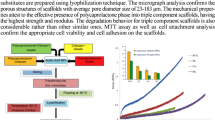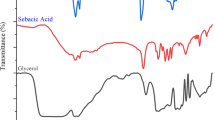Abstract
In this study, a novel porous 3D composite scaffold based on the biodegradable Poly(ε-caprolactone) (PCL), Polylactide Acid (PLA) and Calcium Citrate (CC) was developed via polymer blends and thermal-induced phase separation. The chemical structure, crystalline structure and micromorphology as well as mechanical strength of the scaffolds were characterized by Fourier Transform Infrared Spectroscopy (FTIR), X-ray Diffraction (XRD), Scanning Electron Microscope (SEM) and tensile tests. The results show that the obtained composite scaffold present a suitable bone-like porous structure and sufficient mechanical strength. Furthermore, the release of calcium ions in Simulated Body Fluid (SBF) indicates that the composite material can provide a stable calcium-ion environment and maintain a constant pH value during the soaking process. The cell proliferation results from CCK-8 and light microscopy show that MG63 cells exhibit excellent adhesion and proliferation on the stent. At the same time, animal implantation histology confirms that the composite scaffolds have good biocompatibility in vivo. The scaffold material has greatly potential application value in the field of bone tissue engineering.






Similar content being viewed by others
References
De Witte, T. M., Fratila-Apachitei, L. E., Zadpoor, A. A., & Peppas, N. A. (2018). Bone tissue engineering via growth factor delivery: From scaffolds to complex matrices. Regenerative Biomaterials, 5, 197–211.
Lai, Y. X., Cao, H. J., Wang, X. L., Chen, S. K., Zhang, M., Wang, N., Yao, Z. H., Dai, Y., Xie, X. H., Zhang, P., Yao, X. S., & Qin, L. (2018). Porous composite scaffold incorporating osteogenic phytomolecule icariin for promoting skeletal regeneration in challenging osteonecrotic bone in rabbits. Biomaterials, 153, 1–13.
Cui, L. G., Zhang, N., Cui, W. W., Zhang, P. B., & Chen, X. S. (2015). A novel nano/micro-fibrous scaffold by melt-spinning method for bone tissue engineering. Journal of Bionic Engineering, 12, 117–128.
Han, J., Wu, L. P., Liu, X. B., Hou, J., Zhao, L. L., Chen, J. Y., Zhao, D. H., & Xiang, H. (2017). Biodegradation and biocompatibility of haloarchaea-produced poly(3-hydroxybutyrate-co-3-hydroxyvalerate) copolymers. Biomaterials, 139, 172–186.
Strehin, I., Nahas, Z., Arora, K., Nguyen, T., & Elisseeff, J. (2010). A versatile pH sensitive chondroitin sulfate–PEG tissue adhesive and hydrogel. Biomaterials, 31, 2788–2797.
Salerno, A., Di Maio, E., Iannace, S., & Netti, P. A. (2012). Tailoring the pore structure of PCL scaffolds for tissue engineering prepared via gas foaming of multi-phase blends. Journal of Porous Materials, 19, 181–188.
Patrício, T., & Bártolo, P. (2013). Thermal stability of PCL/PLA blends produced by physical blending process. Procedia Engineering, 59, 292–297.
Kelnar, I., Kratochvíl, J., & Kaprálková, L. (2015). Crystallization and thermal properties of melt-drawn PCL/PLA microfibrillar composites. Journal of Thermal Analysis and Calorimetry, 124, 799–805.
Hidalgo Pitaluga, L., Trevelin Souza, M., Dutra Zanotto, E., Santocildes Romero, M. E., & Hatton, P. V. (2018). Electrospun f18 bioactive glass/PCL-poly (epsilon-caprolactone)-membrane for guided tissue regeneration. Materials (Basel), 11, 400–413.
Malikmammadov, E., Tanir, T. E., Kiziltay, A., Hasirci, V., & Hasirci, N. (2018). PCL and PCL-based materials in biomedical applications. Journal of Biomaterials Science-Polymer Edition, 29, 863–893.
Nyberg, E., Rindone, A., Dorafshar, A., & Grayson, W. L. (2017). Comparison of 3D-printed poly-ɛ-caprolactone scaffolds functionalized with tricalcium phosphate, hydroxyapatite, bio-oss, or decellularized bone matrix. Tissue Engineering Part A, 23, 503–514.
Xu, W. H., Shen, R. Z., Yan, Y. R., & Gao, J. (2017). Preparation and characterization of electrospun alginate/PLA nanofibers as tissue engineering material by emulsion eletrospinning. Journal of the Mechanical Behavior of Biomedical Materials, 65, 428–438.
Tyler, B., Gullotti, D., Mangraviti, A., Utsuki, T., & Brem, H. (2016). Polylactic acid (PLA) controlled delivery carriers for biomedical applications. Advanced Drug Delivery Reviews, 107, 163–175.
Sha, L. L., Chen, Z. F., Chen, Z., Zhang, A. L., & Yang, Z. G. (2016). Polylactic acid based nanocomposites: Promising safe and biodegradable materials in biomedical field. International Journal of Polymer Science, 2016, 1–11.
Tanakaa, T., Eguchia, S., Saitoha, H., Taniguchia, M., & Lloydb, D. R. (2008). Microporous foams of polymer blends of poly(L-lactic acid) and poly(ε-caprolactone). Desalination, 234, 175–183.
Kratochvíl, J., & Kelnar, I. (2016). Non-isothermal crystallization kinetics in melt-drawn PCL/PLA microfibrillar composites. Journal of Thermal Analysis and Calorimetry, 124, 799–805.
Patrício, T., Domingos, M., Gloria, A., D’Amora, U., Coelho, J. F., & Bártolo, P. J. (2014). Fabrication and characterisation of PCL and PCL/PLA scaffolds for tissue engineering. Rapid Prototyping Journal, 20, 145–156.
Yao, Q. Q., Cosme, J. G. L., Xu, T., Miszuk, J. M., Picciani, P. H. S., Fong, H., & Sun, H. L. (2016). Three dimensional electrospun PCL/PLA blend nanofibrous scaffolds with significantly improved stem cells osteogenic differentiation and cranial bone formation. Biomaterials, 115, 115–127.
Maeno, S., Niki, Y., Matsumoto, H., Morioka, H., Yatabe, T., Funayama, A., Toyama, Y., Taguchi, T., & Tanaka, J. (2005). The effect of calcium ion concentration on osteoblast viability, proliferation and differentiation in monolayer and 3D culture. Biomaterials, 26, 4847–4855.
Shao, C. Y., Zhao, R. B., Jiang, S. Q., Yao, S. S., Wu, Z. F., Jin, B., Yang, Y. L., Pan, H. H., & Tang, R. K. (2018). Citrate improves collagen mineralization via interface wetting: A physicochemical understanding of biomineralization control. Advanced Materials, 30, 7.
Tang, J. J., Guo, J. S., Li, Z., Yang, C., Xie, D. H., Chen, J., Li, S. F., Li, S. L., Kim, G. B., Bai, X. C., Zhang, Z. M., & Yang, J. (2015). A fast degradable citrate-based bone scaffold promotes spinal fusion. Journal of Materials Chemistry B, 3, 5569–5576.
Li, J. F., Liu, Y. Q., Gao, Y., Zhong, L. Z., Zou, Q., & Lai, X. F. (2016). Preparation and properties of calcium citrate nanosheets for bone graft substitute. Bioengineered Bugs, 7, 376–381.
Gao, Y., Li, J. F., Liu, Y. Q., Zhong, L. Z., Shu, C. Z., Yue, B., & Zhang, W. T. (2017). Shape-controlled porous carbon from calcium citrate precursor and their intriguing application in lithium-ion batteries. Ionics, 23, 2301–2310.
Nampoothiri, K. M., Nair, N. R., & John, R. P. (2010). An overview of the recent developments in polylactide (PLA) research. Bioresource Technology, 101, 8493–8501.
Ni, Y. N., & Wu, Y. L. (1997). Simultaneous determination of mixtures of metal ions by complexometric titration and multivariate calibration. Analytica Chimica Acta, 354, 233–240.
Kokubo, T., & Takadama, H. (2006). How useful is SBF in predicting in vivo bone bioactivity? Biomaterials, 27, 2907–2915.
Scaglione, S., Ceseracciu, L., Aiello, M., Coluccino, L., Ferrazzo, F., Giannoni, P., & Quarto, R. (2014). A novel scaffold geometry for chondral applications: Theoretical model and in vivo validation. Biotechnology and Bioengineering, 111, 2107–2119.
Karageorgiou, V., & Kaplan, D. (2005). Porosity of 3D biomaterial scaffolds and osteogenesis. Biomaterials, 26, 5474–5491.
Cavo, M., & Scaglione, S. (2016). Scaffold microstructure effects on functional and mechanical performance: Integration of theoretical and experimental approaches for bone tissue engineering applications. Materials Science & Engineering C-Materials for Biological Applications, 68, 872–879.
Acknowledgements
This work was jointly supported by the National Natural Science Foundation of China (NO. 41673109), Sichuan Science and Technology Program (2021YFH0098), and Key Project of Sichuan Vanadium and Titanium Industry Development Research Center (2018VTCY-Z-01).
Author information
Authors and Affiliations
Corresponding authors
Ethics declarations
Conflict of interest
The authors declare that they have no conflict of interest.
Additional information
Publisher's Note
Springer Nature remains neutral with regard to jurisdictional claims in published maps and institutional affiliations.
Supplementary Information
Below is the link to the electronic supplementary material.
Rights and permissions
About this article
Cite this article
Xiao, Y., Wang, L., Luo, K. et al. 3D Biocompatible Polyester Blend Scaffolds Containing Degradable Calcium Citrate for Bone Tissue Engineering. J Bionic Eng 19, 497–506 (2022). https://doi.org/10.1007/s42235-021-00134-4
Received:
Revised:
Accepted:
Published:
Issue Date:
DOI: https://doi.org/10.1007/s42235-021-00134-4




